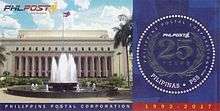Philippine Postal Corporation
| Korporasyong Koreo ng Pilipinas | |
|
| |
| Postal Service overview | |
|---|---|
| Formed |
|
| Preceding Postal Service |
|
| Jurisdiction | Philippines |
| Headquarters | Manila, Philippines |
| Employees | 8,000+ (as of 2014)[1] |
| Postal Service executives | |
| Parent department | Office of the President of the Philippines |
| Website |
www |
The Philippine Postal Corporation, (Filipino: Korporasyong Koreo ng Pilipinas), abbreviated as PHLPost (PhilPost prior to 2012), is a government-owned and controlled corporation responsible for providing postal services in the Philippines. The Philippine Postal Corporation has in excess of 8,000 employees and runs more than 1,355 post offices nationwide.[1] PHLPost is based in the Philippines' primary post office, and is currently headed by Postmaster General and CEO Mr. Joel L. Otarra. The historicManila Central Post Office is situated at the Plaza Liwasang Bonifacio and overlooks the Pasig River. Its policy-making body is the Board of Directors, headed by its Chairman, Mr. Norman Fulgencio. The Board of Directors is composed of seven members including the Postmaster General who serves simultaneously as the chief executive officer.
Previously an attached agency of the Department of Transportation and Communications (DOTC) and the Commission on Information and Communication Technology (CICT), the Philippine Postal Corporation is under the direct jurisdiction of the Office of the President of the Philippines.
The Philippine Postal Savings Bank, one of three government-owned banks in the Philippines, was organized under PHLpost. Now it is a separate company.
History

The Philippine postal system has a history spanning over 250 years. In 1767, the first post office in the Philippines was established in the city of Manila, which was later organized under a new postal district of Spain.[3] In 1779, the postal district encompassed Manila and the entire Philippine archipelago. The postal district was reestablished on 5 December 1837. A year later, Manila became known as a leading center of postal services within Asia. Spain joined the Universal Postal Union in 1875, which was announced in the Philippines two years later.
On 5 December 1837, the first postal service in the Philippines, established by a royal decree in 1767, 70 years earlier, was reorganized. A year later, Manila became known as a leading center of postal services within Asia. Upon its creation in 1767, the first post office was established in the city of Manila, serving mainly to courier government and church documents. It was later organized under a new postal district of Spain, encompassing Manila and the entire Philippine archipelago, in 1779.
During the Philippine Revolution, President Emilio Aguinaldo ordered the establishment of a postal service to provide postal services to Filipinos. It was later organized as a bureau under the Department of Trade on 5 September 1902, by virtue of Act No. 426, which was passed by the Philippine Commission. The Philippines eventually joined the Universal Postal Union, this time as a sovereign entity, on 1 January 1922.

While the Manila Central Post Office building, the center of Philippine postal services and the headquarters of the then-Bureau of Posts, was completed in its present-day Neo-Classical style in 1926, it was destroyed during World War II. After the war, the Central Post Office was rebuilt in 1946.[3]
With the overhaul of the Philippine bureaucracy in 1987, the Bureau of Posts was renamed the Postal Service Office (PSO) by Executive Order No. 125, issued by President Corazon Aquino on 13 April 1987. It was also that order that placed the PSO under the DOTC. On 2 April 1992, by Republic Act No. 7354 the Postal Service Office became the present-day PHLPost.[3] The law also granted the Philippines Postal Corporation, the authority to reopen the Philippine Postal Savings Bank, which occurred on 21 July 1994 by President Fidel V. Ramos. Mr. Joel Otarra, a former member of the Board of Directors in 2011 was appointed as the new Postmaster General and CEO of the Philippine Postal Corporation (PHLPost) on December 2016 by President Rodrigo Roa Duterte.
See also
References
- 1 2 "Highlights of 2014Annual Report" (PDF). PHLPost. 2015. Retrieved 18 February 2017.
- 1 2 "Management Directory" (PDF). Philippine Postal Corporation. Retrieved 2016-05-13.
- 1 2 3 "History/Competitive Edge". 2011. Retrieved March 6, 2012.
External links
| Wikimedia Commons has media related to Philippine Postal Corporation. |